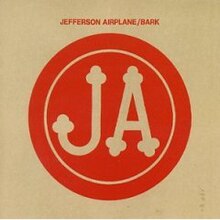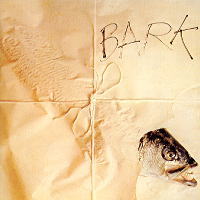When the Earth Moves Again Personnel
| Bark | ||||
|---|---|---|---|---|
 | ||||
| Studio album past Jefferson Aeroplane | ||||
| Released | September 1971 | |||
| Recorded | October 1970 – July 1971 | |||
| Studio | Wally Heider Studios, San Francisco | |||
| Length | 44:17 | |||
| Label | Grunt/RCA Records | |||
| Producer | Jefferson Airplane | |||
| Jefferson Plane chronology | ||||
| ||||
| Culling cover | ||||
 Cardboard sleeve that came with the original vinyl LP release (RCA Victor, 1971) | ||||
Bark is the sixth studio album by American rock band Jefferson Airplane. Released in 1971 as Grunt FTR-1001, the album is one of the Airplane'due south late-catamenia works, notable for the group's starting time personnel changes since 1966. The album was the first without band founder Marty Balin (who departed the band during the recording procedure simply without featuring in the sessions) and the first with violinist Papa John Creach. Drummer Spencer Dryden had been replaced by Joey Covington in early 1970 later on a lengthy transitional menses in which both musicians had performed with the band.
Bark was the Plane's beginning new album in two years, the previous being 1969's Volunteers. Information technology was the offset release on Grunt Records, launched in August 1971 past the ring and RCA equally an autonomous imprint for Jefferson Plane-related releases.
Lead guitarist Jorma Kaukonen received iv songwriting credits on the anthology, indicative of his growing importance equally a composer and singer. At the time, he and bassist Jack Casady had already recorded 2 albums for their spin-off blues stone group Hot Tuna.
The anthology reached number eleven on the Billboard albums chart (outperforming both Volunteers and Kantner'due south Hugo Honor-nominated 1970 solo anthology Blows Against the Empire) and was certified gold by RIAA. An accompanying unmarried, the Covington-led "Pretty as You Feel", was the ring's concluding top 100 American striking, peaking at number sixty in Billboard and number 35 in Cashbox.
Recording history [edit]
Recording sessions for the anthology began in 1970 following the commercial failure of Grace Slick'south "Mexico", a unmarried that railed against the Nixon administration'due south anti-marijuana Operation Intercept initiative. Planned tracks included live versions of "Mexico" and its B-side (the Kantner-penned "Have You Seen the Saucers?"), Balin's "You Wear Your Dresses Too Brusque" and "Emergency", Peter Kaukonen's "Up or Downwards" (sung by Balin), and Covington'due south "Whatever The Sometime Man Does (Is Always Right)" and "The Man (The Bludgeon of the Bluecoat)", a 1950s rhythm and blues pastiche inspired by the contemporaneous murder of journalist Rubén Salazar by a Los Angeles Canton Sheriff'southward Department deputy.[one] [2] [3]
A bout of the United States in support of the band's start greatest hits album (The Worst of Jefferson Airplane) connected through the autumn of 1970, with Creach (a veteran jazz musician who appeared with Nat Rex Cole in Fritz Lang's The Blue Gardenia before meeting Covington at a hiring hall in the tardily 1960s) joining the band and Hot Tuna on the day of Janis Joplin'southward death. Balin did not perform at the band's post-obit concert at Winterland Ballroom on October 5 in remembrance of his close friend but continued with the tour; notwithstanding, he was growing increasingly frustrated with the band'due south drug apply and "playing that messed up cocained music."[2]
Jefferson Airplane stopped touring in November 1970 as Grace Slick and Paul Kantner were about to have a child. China Kantner was born on Jan 25, 1971. "Pretty as Yous Feel" (culled from a longer jam with members of Santana[N 1]) was recorded in January 1971, during Slick's convalescence, while Hot Tuna connected touring and recorded the live First Pull Upwards, So Pull Down in March. Recording sessions resumed in the spring of 1971, just Balin—who had non spoken with his bandmates since the end of the 1970 tour—formally left the group in April.
Kantner later on admitted that the band didn't really know what direction to get in without Balin: "Without Marty at that place was no centrifugal force pulling all the parts together. Without that force it just went ... whew."[4] Slick too commented on the consequence of Balin'due south absence: "Paul'due south a harmony singer. David Freiberg can sing lead only he is more than or less a harmony vocalist too. And then, since at that place is not a powerful lead male vocal that affects the band."[5] Although "The Man" was recorded with Little Richard on piano (much to the consternation of Casady, who felt that his presence was stylistically inappropriate) during this period, new songs were ultimately composed by Kantner, Slick, Kaukonen and Covington in lieu of retaining the 1970-era material.[2] (Balin's songs were dropped because the band didn't desire textile that they couldn't perform alive.[6]) The recording sessions finally concluded at the outset of July 1971, with the resulting album featuring the core 5-fellow member band augmented by Creach on 3 tracks. "Up or Downward" and the studio versions of "Mexico" and "Have Y'all Seen the Saucers?" were later released on the Early Flying compilation.
Release and promotion [edit]
The band played several dates in August in support of the new anthology (including two concerts in the New York metropolitan area and a evidence apiece in Detroit and Philadelphia) but no tour was planned. Only one date (a private party for Grunt Records at San Francisco's Friends and Relations Hall) was played after the album's release in September.
Equally the album climbed the Billboard charts, the band had already moved on to carve up albums for Grunt Records: Kantner and Slick recorded Sunfighter, their first articulation album; Creach worked on his eponymous debut album; and Kaukonen, Casady and Creach finished the offset Hot Tuna studio album, Burgers. With the exception of a couple of dates in early 1972, the band did not play together once more until the recording sessions for Long John Silver in March 1972.
Original vinyl LP release [edit]
The original vinyl LP release featured an outer paper bag with the "JA" logo as though it were bought in a grocery shop with the "JA" emblem as an homage to the original A&P supermarket chain logo. The bag was wrapped effectually the record, which was likewise inside paper. Inside the bag itself was a cardboard embrace for storing the record, that featured a fish with human faux teeth wrapped in paper and tied with string. Too inside the bag was a lyrics sheet insert, colored as pink "butcher paper". The newspaper bag became the cover art for the CD releases, and the fish image appeared on the CD itself.
Disquisitional reaction [edit]
| Review scores | |
|---|---|
| Source | Rating |
| AllMusic | |
| Christgau's Tape Guide | C+[8] |
| The Encyclopedia of Popular Music | |
| Rolling Rock | favorable[x] |
In The Rolling Stone Tape Guide (1st edition, 1979), editor John Swenson wrote: "After Balin left, the group literally savage apart. A cursory heed to the wretched Bark (deleted) will prove the bespeak."
Lester Bangs' original Rolling Rock review (Nov. 11, 1971) was much more than favorable: "If you inquire me, Bawl is the 'Plane's most magnanimous opus since After Bathing at Baxter'due south, and even if its woof and whissshh ain't quite equally supersonic equally some of their other platters, it'll getcha there on time just similar an amyl nitrite TV Dinner garnished this time with a lilliputian Valium. And the zingy rush that Jorma's and Jack'due south reps residue on streams as strongly as always just a bit below the surface of the music with a movement seconded in places past the always judicious application of Papa John's sweetness gypsy-blue fiddle."[11]
Rail listing [edit]
| No. | Title | Writer(s) | Length |
|---|---|---|---|
| i. | "When the Earth Moves Again" | Paul Kantner | three:54 |
| 2. | "Experience Then Proficient" | Jorma Kaukonen | 4:36 |
| 3. | "Crazy Miranda" | Grace Slick | 3:23 |
| iv. | "Pretty every bit Yous Feel" | Joey Covington, Jack Casady, Kaukonen, Carlos Santana,[ii] [12] Michael Shrieve[2] [12] | iv:29 |
| 5. | "Wild Turkey" (Instrumental) | Kaukonen | iv:45 |
| No. | Title | Author(southward) | Length |
|---|---|---|---|
| ane. | "Police Homo" | Slick | 2:42 |
| 2. | "Rock and Curl Isle" | Kantner | 3:44 |
| 3. | "3rd Calendar week in the Chelsea" | Kaukonen | iv:34 |
| iv. | "Never Argue with a High german If You're Tired or European Song" | Slick | 4:31 |
| 5. | "Thunk" | Covington | two:58 |
| six. | "State of war Moving-picture show" | Kantner | 4:41 |
[xiii]
Personnel [edit]
- Jack Casady – bass guitar, bass balalaika
- Joey Covington – percussion, drums, vocals
- Paul Kantner – guitar, vocals
- Jorma Kaukonen – lead guitar, vocals
- Grace Slick – piano, vocals
- Papa John Creach – violin on "Pretty every bit Y'all Experience", "Wild Turkey" and "When the Earth Moves Once more"
Additional personnel [edit]
- Bill Laudner – vocals on "War Picture"
- Will Scarlett – harmonica on "Third Week in the Chelsea"[2] (uncredited)
- Carlos Santana – guitar on "Pretty as You Feel"[14] (uncredited)
- Michael Shrieve – drums on "Pretty as Y'all Feel"[14] (uncredited)
Production [edit]
- Jefferson Airplane – producer, arrangements, additional ideas
- A Train – additional ideas
- Allen Zentz – engineer
- Masterful Maurice (Pat Ieraci) – 16-track
- Acy Lehman – package concept and design
- Grace Slick – portraits
- Bill Thompson – portrait of Grace
- Gary Blackman – art direction, purse verse form
Charts [edit]
| Chart (1971) | Position |
|---|---|
| United states of america Billboard Superlative LPs | 11 |
| Australian (Kent Music Report) | 39[fifteen] |
Singles
| Year | Unmarried | Nautical chart | Position |
|---|---|---|---|
| 1971 | "Pretty as You Feel" | Billboard Hot 100 | 60 |
Notes [edit]
- ^ "Pretty as You Feel" began as a jam between Casady, Covington, Kaukonen, Santana and Shrieve. Covington later isolated a portion of the jam and wrote lyrics for it. Fong-Torres, Ben (November 12, 1970). "Grace Slick with Paul Kantner: The Rolling Rock Interview". Rolling Rock. Archived from the original on February 1, 2016. Retrieved January 19, 2016.
References [edit]
- ^ Kantner, Paul (February 1971). "Paul Kantner". Jazz & Pop (Magazine). Interviewed past Patricia Kennealy.
- ^ a b c d e f Tamarakin, Jeff (2003). Got a Revolution: The Turbulent Flight of Jefferson Airplane. Simon and Schuster. ISBN0-671-03403-0.
- ^ "Web Page Under Construction".
- ^ Snyder, Patrick (Jan ane, 1976). "Jefferson Starship: The Phenomenon Rockers". Rolling Stone . Retrieved October 27, 2015.
- ^ Rob Bowman, ZigZag, October 1974
- ^ Fong-Torres, Ben (September 30, 1971). "Jefferson Airplane Grunts: 'Gotta Development'". Rolling Stone. rollingstone.com.
- ^ Allmusic Review
- ^ Christgau, Robert (1981). "Consumer Guide '70s: J". Christgau'south Tape Guide: Stone Albums of the Seventies. Ticknor & Fields. ISBN089919026X . Retrieved February 27, 2019 – via robertchristgau.com.
- ^ Larkin, Colin (2007). The Encyclopedia of Pop Music (4th ed.). Oxford University Press. ISBN978-0195313734.
- ^ Rolling Stone Review
- ^ Rollingstone
- ^ a b registered every bit author on file with U.s.a. copyright office
- ^ Bawl (Vinyl outer newspaper purse). Jefferson Airplane. San Francisco: Grunt Records. 1971. FTR-1001.
{{cite AV media notes}}: CS1 maint: others in cite AV media (notes) (link) - ^ a b Jefferson Airplane Loves You (booklet). Jefferson Airplane. New York Urban center: RCA. 1992. 61110.
{{cite AV media notes}}: CS1 maint: others in cite AV media (notes) (link) - ^ Kent, David (1993). Australian Chart Volume 1970–1992 (illustrated ed.). St Ives, Due north.S.W.: Australian Chart Book. p. 154. ISBN0-646-11917-6.
Source: https://en.wikipedia.org/wiki/Bark_(Jefferson_Airplane_album)
0 Response to "When the Earth Moves Again Personnel"
Post a Comment